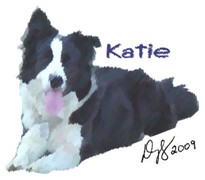Ticked ("T/T")
is incompletely dominant to non-ticked ("t/t"). There are various degrees of ticking from just a few large spots to very heavy
ticking which appears to be roan, similar to the Australian Cattle Dog, German Shorthaired Pointer, and many hounds. Ticking will
dominate over clear white markings. If you breed a ticked dog to a mate with the clear white, some of the pups will be ticked,
some won't. You can tell when a puppy will be ticked as an adult, by looking at the newborn pups nose. If the pup is born
with a solid or completely pigmented nose leather, the pup will be a ticked adult. Breeding two ticked mates together will
produce a whole litter of ticked puppies. Ticking develops over time. The extreme white patterned dogs in the pictures were
non ticked white as pups. Every year they develop more and more spots.
Ticking can
also be called "Mottling".
Some folks
even refer to them as "freckles".
The photos
below show border collies of different ages with different levels of ticking. Some are heavily ticked, while others
are not. These two pups of mine look like they will be lightly ticked, probably about the same as Oaktree Sam (above).

